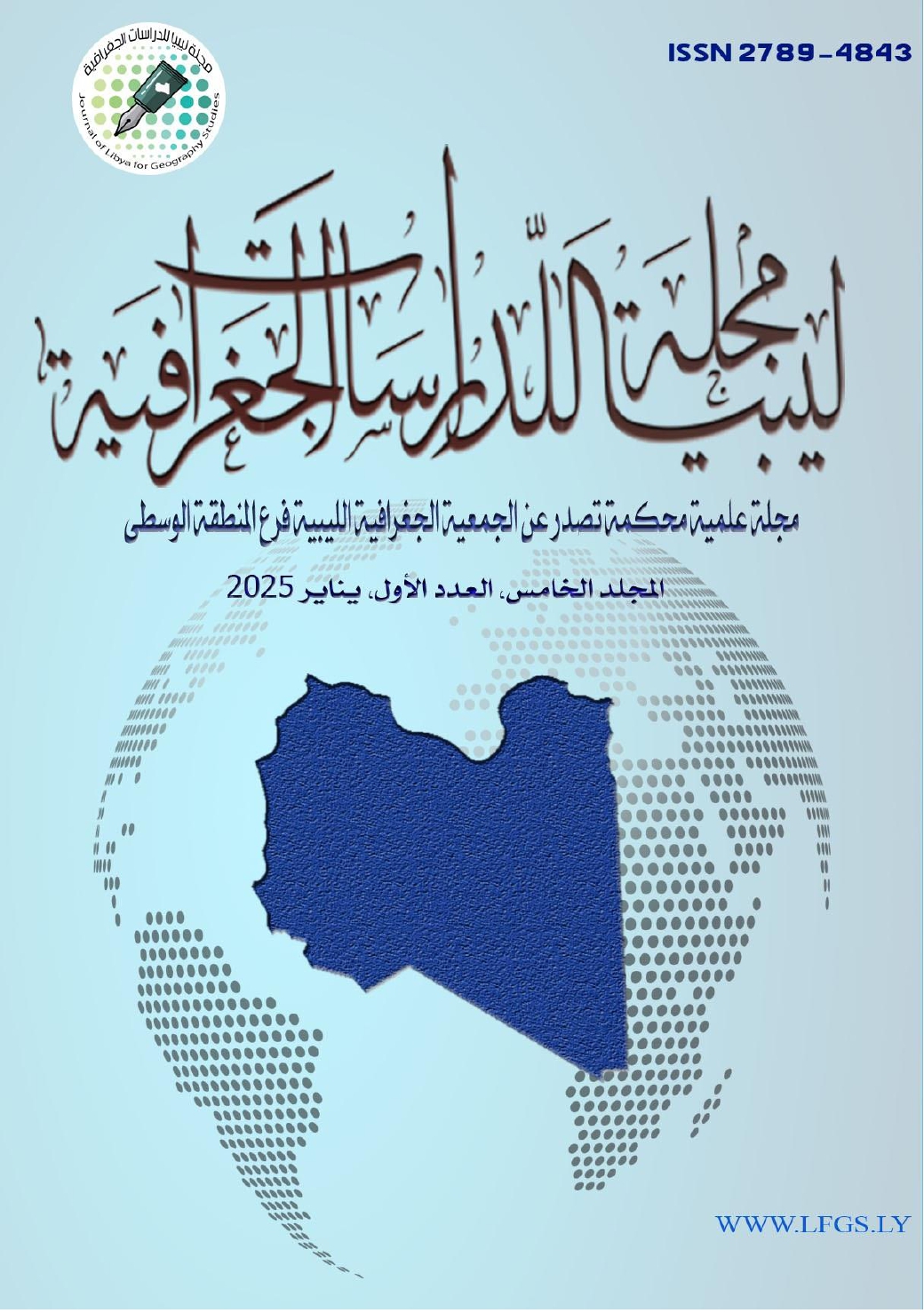The Role of Modern Technologies in Spatial Analysis of Flash Flood Risk Sites: A Case Study of the Al-Abyar Area
DOI:
https://doi.org/10.37375/jlgs.v5i1.3109Keywords:
Flash Flooding, Geospatial Modeling, Hydrology, Geographic Information Systems (GIS)Abstract
In light of the natural challenges posed by flash floods, this study aims to identify and monitor areas threatened by flood risks in a major developmental region. The study relies on advanced hydrological techniques to simulate flash flood risks, thereby enhancing spatial analysis as one of the modern trends in geomorphology, where it is used for precise identification of areas exposed to such risks.
The study also addresses the phenomenon of unplanned urban growth and its impact on flash flooding, utilizing modern technologies such as remote sensing and geographic information systems (GIS), which have proven effective in the study of urban geography, city planning, and management, including service distribution and efficiency, land use mapping, and the identification of informal settlements and deteriorating buildings.
The study area includes the Al-Abyar Valley Basin, covering an area of 678 km², where an urban settlement has been established at the basin's outlet, making flash flooding a threat to urban development. The area has experienced several rainstorms in recent years, prompting the researcher to conduct a detailed study using one of these storms as a case study to assess the risk and determine its geospatial dimensions.
This study aims to conduct a comprehensive analysis of the risks associated with flash flooding in the study area, including geomorphological and hydrological considerations, and to provide an accurate assessment of the natural and environmental conditions. The focus is on factors such as land leveling, natural terrain slope, and soil quality. It also presents recommendations to raise awareness of flash flood risks and applies several hydromorphological equations to identify sites threatened by flash flood risks.
References
- أحمد سعيد حبوب، (1986): جغرافية الطقس، بغداد، دار الكتب للطباعة.
- المسلاتي، أمين، (1995)، أمين، التطور الجيولوجي والتكتوني، في كتاب الجماهيرية دراسة في الجغرافيا، تحرير: الهادي بولقمة، سعد القزيري، الدار الجماهيرية للنشر والتوزيع والإعلان، سرت.
- المغاري، باسم عبد الرحمن خليل، (2015م)، الخصائص المورفومترية لحوض وادي الحسي باستخدام نظم المعلومات الجغرافية، رسالة ماجستير (غير منشورة)، الجامعة الإسلامية، غزة.
- جودة، حسنين جودة، (1973)، أبحاث في جيومورفولوجية الأراضي الليبية، الجزء الأول، منشورات الجامعة الليبية، بنغازي.
- بوقرين، رافع حامد، (2012)، تأثير غبار المحاجر على نبات السدر بمنطقة جنوب الأبيار، رسالة ماجستير (غير منشورة)، قسم علم النبات، كلية العلوم، جامعة بنغازي.
- عبدالجواد، صبحي عبد الحميد، و الكيالي، مني عبد الرحمن يس، (2022)، النمذجة الهيدرولوجية ثنائية الأبعاد للجريان السيلي، حوض وادي الجمال، البحر الأحمر، مصر، باستخدام تطبيقات الجيوماتكس، مجلة كلية الآداب، جامعة بورسعيد، المجلد الاول، العدد الرابع، أكتوبر 2022م
- عبد الرحمن، عبد الرحمن، جاك ومارديني، (2003)، علم حركة المياه "الهيدرولوجيا"، مديرية الكتب والمطبوعات الجامعية، منشورات جامعة حلب، كلية الهندسة المدنية، حلب.
- عبد العزيز، طريح شرف، (1993)، جغرافية ليبيا، مؤسسة الثقافة الجامعية، الإسكندرية.
- فتح الله، علاء جابر، (2018)، دور الخصائص الطبيعية المورفومترية ومدلولاتها الهيدرولوجية في حوض وادي السهل الغربي غرب مدينة طبرق شمال شرق ليبيا، مجلة جامعة سرت للعلوم الإنسانية، المجلة8، العدد2.
- الفيتوري، علي محمد، (2015)، الخصائص المورفومترية والهيدرولوجية لحوض وادي القطارة دراسة مقارنة ما بين استخدام الطرق التقليدية وبرمجيات نظم المعلومات الجغرافية، المجلة الليبية العالمية، كلية التربية المرج، جامعة بنغازي، العدد الثالث.
- العريشي، علي محمد شيبان، (1422ه)، سهل تهامة في منطقة جازان بالمملكة العربية السعودية: دراسة تحليلية تقييمية للنمط الزراعي الحديث، جامعة الكويت، كلية العلوم الاجتماعية، قسم الجغرافيا.
- الهرام، فتحي أحمد، و تراب، محمد مجدي، (1990)، حول التطور الجيومورفولوجي لبعض الأودية بالجبل الأخضر باستخدام التحليل المورفومترية، مجلة جامعة قاريونس العلمية، السنة الثالثة، العدد 4.
- عبدالعالي، فجرية عثمان، (2016)، التحليل المورفومترية لبعض أودية الجبل الأخضر في المنطقة الممتدة من درنة إلى سوسة باستخدام نظم المعلومات الجغرافية، رسالة ماجستير (غير منشورة)، قسم الجغرافيا، كلية الآداب، جامعة بنغازي، ليبيا.
- البارودي، محمد سعيد، (2012)، تقدير أحجام السيول وأخطارها عند المجرى الأدنى لوادي عرنة جنوب شرق مكة المكرمة باستخدام نظم المعلومات الجغرافية، سلسلة بحوث جغرافية، جامعة أم القرى، العدد 48.
- عاشور، محمود محمد، و جودة، حسنين، و تراب، محمد مجدي، و رمضان، محمد، (1991)، المسح الجيومورفولوجي، أساليبه ومجالاته، الفصل الأول، في كتاب وسائل التحليل الجيومورفولوجي، الطبعة الأولى، بدون ناشر، القاهرة.
- مركز البحوث الصناعية، (1974)، خريطة ليبيا الجيولوجية 250.000:1، الكتيب التفسيري لوحة سلوق، طرابلس.
- EI-Hawat, A.S. and Salem, M.J., 1987. A Case Study of the stratigraphic subdivision of AR- Rajmah Fm. and its Implication on the Miocene of Northern Libya. in: Proc. Illth Cong. Med. Neogene Stratig., Budapest. Ann. last. Geol. Publ. Hung., Budapest, LXX: pp.173-184.
- El-Hawat, A.S., Abdulsamad, E.O. 2004. The geology of Cyrenaica: a field seminar. Proceedings of the 3rd Symposium on the Sedimentary Basins of Libya: Geology of East Libya. Tripoli, Earth Science Society of Libya, 130pp.
- Gatimel.A& Pons. A., )2000(: Etude Hydrologique Du Bassin Versant Du Saleix, Science de l'eau et de l’environnement. Parde
- Raghunath H, M. (2006): Hydrology: principles analysis and design; Revisal Second Edition Limited, New Delhi: P. 150
- Raghunath, H.M., (1991): Hydrology: Principles, Analysis and Design. Wiley Eastern Limited, New DelhiRaghunath,1991, p.98
- Raghunath, H.M., (1991): Hydrology: Principles, Analysis and Design. Wiley Eastern Limited, New DelhiRaghunath,1991, p.102
- Réméniéras, G., (1972): Hydrologie De l’Ingénieur, Eyrolles, 3ème Edition, Paris P. 138
- Young, A. (1972): Slopes, Oliver & Boyed, Edinburgh, P.173.














